[English] 日本語
 Yorodumi
Yorodumi- EMDB-12351: Human ATM kinase with bound inhibitor KU-55933 (composite structure) -
+ Open data
Open data
- Basic information
Basic information
| Entry | Database: EMDB / ID: EMD-12351 | |||||||||||||||
|---|---|---|---|---|---|---|---|---|---|---|---|---|---|---|---|---|
| Title | Human ATM kinase with bound inhibitor KU-55933 (composite structure) | |||||||||||||||
 Map data Map data | Human ATM full length with bound inhibitor KU-55933 composite map LAFTER filtered | |||||||||||||||
 Sample Sample |
| |||||||||||||||
 Keywords Keywords | Kinase / inhibitor / DNA damage response / cancer research / SIGNALING PROTEIN | |||||||||||||||
| Function / homology |  Function and homology information Function and homology informationestablishment of RNA localization to telomere / positive regulation of telomerase catalytic core complex assembly / cellular response to nitrosative stress / negative regulation of telomere capping / Sensing of DNA Double Strand Breaks / establishment of protein-containing complex localization to telomere / peptidyl-serine autophosphorylation / meiotic telomere clustering / positive regulation of telomere maintenance via telomere lengthening / pre-B cell allelic exclusion ...establishment of RNA localization to telomere / positive regulation of telomerase catalytic core complex assembly / cellular response to nitrosative stress / negative regulation of telomere capping / Sensing of DNA Double Strand Breaks / establishment of protein-containing complex localization to telomere / peptidyl-serine autophosphorylation / meiotic telomere clustering / positive regulation of telomere maintenance via telomere lengthening / pre-B cell allelic exclusion / DNA-dependent protein kinase activity / male meiotic nuclear division / extrinsic component of synaptic vesicle membrane / histone H2AXS139 kinase activity / histone mRNA catabolic process / regulation of telomere maintenance via telomerase / female meiotic nuclear division / lipoprotein catabolic process / DNA double-strand break processing / regulation of autophagosome assembly / cellular response to X-ray / V(D)J recombination / pexophagy / oocyte development / Impaired BRCA2 binding to PALB2 / DNA repair complex / reciprocal meiotic recombination / positive regulation of DNA damage response, signal transduction by p53 class mediator / Homologous DNA Pairing and Strand Exchange / Defective homologous recombination repair (HRR) due to BRCA1 loss of function / Defective HDR through Homologous Recombination Repair (HRR) due to PALB2 loss of BRCA1 binding function / Defective HDR through Homologous Recombination Repair (HRR) due to PALB2 loss of BRCA2/RAD51/RAD51C binding function / Resolution of D-loop Structures through Synthesis-Dependent Strand Annealing (SDSA) / 1-phosphatidylinositol-3-kinase activity / Resolution of D-loop Structures through Holliday Junction Intermediates / HDR through Single Strand Annealing (SSA) / response to ionizing radiation / negative regulation of B cell proliferation / TP53 Regulates Transcription of Caspase Activators and Caspases / cellular response to stress / mitotic spindle assembly checkpoint signaling / Impaired BRCA2 binding to RAD51 / positive regulation of double-strand break repair / mitotic G2 DNA damage checkpoint signaling / TP53 Regulates Transcription of Genes Involved in Cytochrome C Release / peroxisomal matrix / Presynaptic phase of homologous DNA pairing and strand exchange / replicative senescence / signal transduction in response to DNA damage / Regulation of HSF1-mediated heat shock response / somitogenesis / regulation of cellular response to heat / ovarian follicle development / cellular response to retinoic acid / negative regulation of TORC1 signaling / positive regulation of telomere maintenance via telomerase / positive regulation of cell adhesion / telomere maintenance / Pexophagy / DNA damage checkpoint signaling / thymus development / regulation of signal transduction by p53 class mediator / determination of adult lifespan / post-embryonic development / cellular response to reactive oxygen species / TP53 Regulates Transcription of DNA Repair Genes / DNA damage response, signal transduction by p53 class mediator / Stabilization of p53 / Nonhomologous End-Joining (NHEJ) / Autodegradation of the E3 ubiquitin ligase COP1 / cellular response to gamma radiation / double-strand break repair via homologous recombination / G2/M DNA damage checkpoint / brain development / Regulation of TP53 Activity through Methylation / HDR through Homologous Recombination (HRR) / double-strand break repair via nonhomologous end joining / DNA Damage/Telomere Stress Induced Senescence / Meiotic recombination / multicellular organism growth / spindle / intrinsic apoptotic signaling pathway in response to DNA damage / cellular senescence / Regulation of TP53 Degradation / double-strand break repair / positive regulation of neuron apoptotic process / Recruitment and ATM-mediated phosphorylation of repair and signaling proteins at DNA double strand breaks / chromosome / site of double-strand break / heart development / protein autophosphorylation / Processing of DNA double-strand break ends / neuron apoptotic process / regulation of apoptotic process / Regulation of TP53 Activity through Phosphorylation / protein phosphorylation / non-specific serine/threonine protein kinase / regulation of cell cycle / regulation of autophagy / positive regulation of cell migration Similarity search - Function | |||||||||||||||
| Biological species |  Homo sapiens (human) Homo sapiens (human) | |||||||||||||||
| Method | single particle reconstruction / cryo EM / Resolution: 2.78 Å | |||||||||||||||
 Authors Authors | Bartho JD / Stakyte K / Rotheneder M / Lammens K / Hopfner KP | |||||||||||||||
| Funding support |  Germany, 4 items Germany, 4 items
| |||||||||||||||
 Citation Citation |  Journal: Nat Struct Mol Biol / Year: 2021 Journal: Nat Struct Mol Biol / Year: 2021Title: Molecular basis of human ATM kinase inhibition. Authors: K Stakyte / M Rotheneder / K Lammens / J D Bartho / U Grädler / T Fuchß / U Pehl / A Alt / E van de Logt / K P Hopfner /  Abstract: Human checkpoint kinase ataxia telangiectasia-mutated (ATM) plays a key role in initiation of the DNA damage response following DNA double-strand breaks. ATM inhibition is a promising approach in ...Human checkpoint kinase ataxia telangiectasia-mutated (ATM) plays a key role in initiation of the DNA damage response following DNA double-strand breaks. ATM inhibition is a promising approach in cancer therapy, but, so far, detailed insights into the binding modes of known ATM inhibitors have been hampered due to the lack of high-resolution ATM structures. Using cryo-EM, we have determined the structure of human ATM to an overall resolution sufficient to build a near-complete atomic model and identify two hitherto unknown zinc-binding motifs. We determined the structure of the kinase domain bound to ATPγS and to the ATM inhibitors KU-55933 and M4076 at 2.8 Å, 2.8 Å and 3.0 Å resolution, respectively. The mode of action and selectivity of the ATM inhibitors can be explained by structural comparison and provide a framework for structure-based drug design. | |||||||||||||||
| History |
|
- Structure visualization
Structure visualization
| Movie |
 Movie viewer Movie viewer |
|---|---|
| Structure viewer | EM map:  SurfView SurfView Molmil Molmil Jmol/JSmol Jmol/JSmol |
| Supplemental images |
- Downloads & links
Downloads & links
-EMDB archive
| Map data |  emd_12351.map.gz emd_12351.map.gz | 599.6 MB |  EMDB map data format EMDB map data format | |
|---|---|---|---|---|
| Header (meta data) |  emd-12351-v30.xml emd-12351-v30.xml emd-12351.xml emd-12351.xml | 18.7 KB 18.7 KB | Display Display |  EMDB header EMDB header |
| Images |  emd_12351.png emd_12351.png | 26.8 KB | ||
| Filedesc metadata |  emd-12351.cif.gz emd-12351.cif.gz | 8 KB | ||
| Archive directory |  http://ftp.pdbj.org/pub/emdb/structures/EMD-12351 http://ftp.pdbj.org/pub/emdb/structures/EMD-12351 ftp://ftp.pdbj.org/pub/emdb/structures/EMD-12351 ftp://ftp.pdbj.org/pub/emdb/structures/EMD-12351 | HTTPS FTP |
-Validation report
| Summary document |  emd_12351_validation.pdf.gz emd_12351_validation.pdf.gz | 406.5 KB | Display |  EMDB validaton report EMDB validaton report |
|---|---|---|---|---|
| Full document |  emd_12351_full_validation.pdf.gz emd_12351_full_validation.pdf.gz | 406 KB | Display | |
| Data in XML |  emd_12351_validation.xml.gz emd_12351_validation.xml.gz | 9.2 KB | Display | |
| Data in CIF |  emd_12351_validation.cif.gz emd_12351_validation.cif.gz | 10.7 KB | Display | |
| Arichive directory |  https://ftp.pdbj.org/pub/emdb/validation_reports/EMD-12351 https://ftp.pdbj.org/pub/emdb/validation_reports/EMD-12351 ftp://ftp.pdbj.org/pub/emdb/validation_reports/EMD-12351 ftp://ftp.pdbj.org/pub/emdb/validation_reports/EMD-12351 | HTTPS FTP |
-Related structure data
| Related structure data |  7ni5MC  7ni4C  7ni6C C: citing same article ( M: atomic model generated by this map |
|---|---|
| Similar structure data |
- Links
Links
| EMDB pages |  EMDB (EBI/PDBe) / EMDB (EBI/PDBe) /  EMDataResource EMDataResource |
|---|---|
| Related items in Molecule of the Month |
- Map
Map
| File |  Download / File: emd_12351.map.gz / Format: CCP4 / Size: 1000 MB / Type: IMAGE STORED AS FLOATING POINT NUMBER (4 BYTES) Download / File: emd_12351.map.gz / Format: CCP4 / Size: 1000 MB / Type: IMAGE STORED AS FLOATING POINT NUMBER (4 BYTES) | ||||||||||||||||||||||||||||||||||||||||||||||||||||||||||||||||||||
|---|---|---|---|---|---|---|---|---|---|---|---|---|---|---|---|---|---|---|---|---|---|---|---|---|---|---|---|---|---|---|---|---|---|---|---|---|---|---|---|---|---|---|---|---|---|---|---|---|---|---|---|---|---|---|---|---|---|---|---|---|---|---|---|---|---|---|---|---|---|
| Annotation | Human ATM full length with bound inhibitor KU-55933 composite map LAFTER filtered | ||||||||||||||||||||||||||||||||||||||||||||||||||||||||||||||||||||
| Projections & slices | Image control
Images are generated by Spider. | ||||||||||||||||||||||||||||||||||||||||||||||||||||||||||||||||||||
| Voxel size | X=Y=Z: 0.5295 Å | ||||||||||||||||||||||||||||||||||||||||||||||||||||||||||||||||||||
| Density |
| ||||||||||||||||||||||||||||||||||||||||||||||||||||||||||||||||||||
| Symmetry | Space group: 1 | ||||||||||||||||||||||||||||||||||||||||||||||||||||||||||||||||||||
| Details | EMDB XML:
CCP4 map header:
| ||||||||||||||||||||||||||||||||||||||||||||||||||||||||||||||||||||
-Supplemental data
- Sample components
Sample components
-Entire : ATM dimer with bound KU-55933
| Entire | Name: ATM dimer with bound KU-55933 |
|---|---|
| Components |
|
-Supramolecule #1: ATM dimer with bound KU-55933
| Supramolecule | Name: ATM dimer with bound KU-55933 / type: complex / ID: 1 / Parent: 0 / Macromolecule list: #1 |
|---|---|
| Source (natural) | Organism:  Homo sapiens (human) Homo sapiens (human) |
-Macromolecule #1: Serine-protein kinase ATM
| Macromolecule | Name: Serine-protein kinase ATM / type: protein_or_peptide / ID: 1 / Number of copies: 2 / Enantiomer: LEVO / EC number: non-specific serine/threonine protein kinase |
|---|---|
| Source (natural) | Organism:  Homo sapiens (human) Homo sapiens (human) |
| Molecular weight | Theoretical: 354.526188 KDa |
| Recombinant expression | Organism:  Homo sapiens (human) Homo sapiens (human) |
| Sequence | String: MDYKDDDDKG TDYKDDDDKS GSLEVLFQGP MSLVLNDLLI CCRQLEHDRA TERKKEVEKF KRLIRDPETI KHLDRHSDSK QGKYLNWDA VFRFLQKYIQ KETECLRIAK PNVSASTQAS RQKKMQEISS LVKYFIKCAN RRAPRLKCQE LLNYIMDTVK D SSNGAIYG ...String: MDYKDDDDKG TDYKDDDDKS GSLEVLFQGP MSLVLNDLLI CCRQLEHDRA TERKKEVEKF KRLIRDPETI KHLDRHSDSK QGKYLNWDA VFRFLQKYIQ KETECLRIAK PNVSASTQAS RQKKMQEISS LVKYFIKCAN RRAPRLKCQE LLNYIMDTVK D SSNGAIYG ADCSNILLKD ILSVRKYWCE ISQQQWLELF SVYFRLYLKP SQDVHRVLVA RIIHAVTKGC CSQTDGLNSK FL DFFSKAI QCARQEKSSS GLNHILAALT IFLKTLAVNF RIRVCELGDE ILPTLLYIWT QHRLNDSLKE VIIELFQLQI YIH HPKGAK TQEKGAYEST KWRSILYNLY DLLVNEISHI GSRGKYSSGF RNIAVKENLI ELMADICHQV FNEDTRSLEI SQSY TTTQR ESSDYSVPCK RKKIELGWEV IKDHLQKSQN DFDLVPWLQI ATQLISKYPA SLPNCELSPL LMILSQLLPQ QRHGE RTPY VLRCLTEVAL CQDKRSNLES SQKSDLLKLW NKIWCITFRG ISSEQIQAEN FGLLGAIIQG SLVEVDREFW KLFTGS ACR PSCPAVCCLT LALTTSIVPG TVKMGIEQNM CEVNRSFSLK ESIMKWLLFY QLEGDLENST EVPPILHSNF PHLVLEK IL VSLTMKNCKA AMNFFQSVPE CEHHQKDKEE LSFSEVEELF LQTTFDKMDF LTIVRECGIE KHQSSIGFSV HQNLKESL D RCLLGLSEQL LNNYSSEITN SETLVRCSRL LVGVLGCYCY MGVIAEEEAY KSELFQKAKS LMQCAGESIT LFKNKTNEE FRIGSLRNMM QLCTRCLSNC TKKSPNKIAS GFFLRLLTSK LMNDIADICK SLASFIKKPF DRGEVESMED DTNGNLMEVE DQSSMNLFN DYPDSSVSDA NEPGESQSTI GAINPLAEEY LSKQDLLFLD MLKFLCLCVT TAQTNTVSFR AADIRRKLLM L IDSSTLEP TKSLHLHMYL MLLKELPGEE YPLPMEDVLE LLKPLSNVCS LYRRDQDVCK TILNHVLHVV KNLGQSNMDS EN TRDAQGQ FLTVIGAFWH LTKERKYIFS VRMALVNCLK TLLEADPYSK WAILNVMGKD FPVNEVFTQF LADNHHQVRM LAA ESINRL FQDTKGDSSR LLKALPLKLQ QTAFENAYLK AQEGMREMSH SAENPETLDE IYNRKSVLLT LIAVVLSCSP ICEK QALFA LCKSVKENGL EPHLVKKVLE KVSETFGYRR LEDFMASHLD YLVLEWLNLQ DTEYNLSSFP FILLNYTNIE DFYRS CYKV LIPHLVIRSH FDEVKSIANQ IQEDWKSLLT DCFPKILVNI LPYFAYEGTR DSGMAQQRET ATKVYDMLKS ENLLGK QID HLFISNLPEI VVELLMTLHE PANSSASQST DLCDFSGDLD PAPNPPHFPS HVIKATFAYI SNCHKTKLKS ILEILSK SP DSYQKILLAI CEQAAETNNV YKKHRILKIY HLFVSLLLKD IKSGLGGAWA FVLRDVIYTL IHYINQRPSC IMDVSLRS F SLCCDLLSQV CQTAVTYCKD ALENHLHVIV GTLIPLVYEQ VEVQKQVLDL LKYLVIDNKD NENLYITIKL LDPFPDHVV FKDLRITQQK IKYSRGPFSL LEEINHFLSV SVYDALPLTR LEGLKDLRRQ LELHKDQMVD IMRASQDNPQ DGIMVKLVVN LLQLSKMAI NHTGEKEVLE AVGSCLGEVG PIDFSTIAIQ HSKDASYTKA LKLFEDKELQ WTFIMLTYLN NTLVEDCVKV R SAAVTCLK NILATKTGHS FWEIYKMTTD PMLAYLQPFR TSRKKFLEVP RFDKENPFEG LDDINLWIPL SENHDIWIKT LT CAFLDSG GTKCEILQLL KPMCEVKTDF CQTVLPYLIH DILLQDTNES WRNLLSTHVQ GFFTSCLRHF SQTSRSTTPA NLD SESEHF FRCCLDKKSQ RTMLAVVDYM RRQKRPSSGT IFNDAFWLDL NYLEVAKVAQ SCAAHFTALL YAEIYADKKS MDDQ EKRSL AFEEGSQSTT ISSLSEKSKE ETGISLQDLL LEIYRSIGEP DSLYGCGGGK MLQPITRLRT YEHEAMWGKA LVTYD LETA IPSSTRQAGI IQALQNLGLC HILSVYLKGL DYENKDWCPE LEELHYQAAW RNMQWDHCTS VSKEVEGTSY HESLYN ALQ SLRDREFSTF YESLKYARVK EVEEMCKRSL ESVYSLYPTL SRLQAIGELE SIGELFSRSV THRQLSEVYI KWQKHSQ LL KDSDFSFQEP IMALRTVILE ILMEKEMDNS QRECIKDILT KHLVELSILA RTFKNTQLPE RAIFQIKQYN SVSCGVSE W QLEEAQVFWA KKEQSLALSI LKQMIKKLDA SCAANNPSLK LTYTECLRVC GNWLAETCLE NPAVIMQTYL EKAVEVAGN YDGESSDELR NGKMKAFLSL ARFSDTQYQR IENYMKSSEF ENKQALLKRA KEEVGLLREH KIQTNRYTVK VQRELELDEL ALRALKEDR KRFLCKAVEN YINCLLSGEE HDMWVFRLCS LWLENSGVSE VNGMMKRDGM KIPTYKFLPL MYQLAARMGT K MMGGLGFH EVLNNLISRI SMDHPHHTLF IILALANANR DEFLTKPEVA RRSRITKNVP KQSSQLDEDR TEAANRIICT IR SRRPQMV RSVEALCDAY IILANLDATQ WKTQRKGINI PADQPITKLK NLEDVVVPTM EIKVDHTGEY GNLVTIQSFK AEF RLAGGV NLPKIIDCVG SDGKERRQLV KGRDDLRQDA VMQQVFQMCN TLLQRNTETR KRKLTICTYK VVPLSQRSGV LEWC TGTVP IGEFLVNNED GAHKRYRPND FSAFQCQKKM MEVQKKSFEE KYEVFMDVCQ NFQPVFRYFC MEKFLDPAIW FEKRL AYTR SVATSSIVGY ILGLGDRHVQ NILINEQSAE LVHIDLGVAF EQGKILPTPE TVPFRLTRDI VDGMGITGVE GVFRRC CEK TMEVMRNSQE TLLTIVEVLL YDPLFDWTMN PLKALYLQQR PEDETELHPT LNADDQECKR NLSDIDQSFN KVAERVL MR LQEKLKGVEE GTVLSVGGQV NLLIQQAIDP KNLSRLFPGW KAWV UniProtKB: Serine-protein kinase ATM |
-Macromolecule #2: 2-morpholin-4-yl-6-thianthren-1-yl-pyran-4-one
| Macromolecule | Name: 2-morpholin-4-yl-6-thianthren-1-yl-pyran-4-one / type: ligand / ID: 2 / Number of copies: 2 / Formula: UF8 |
|---|---|
| Molecular weight | Theoretical: 395.495 Da |
| Chemical component information |  ChemComp-UF8: |
-Macromolecule #3: ZINC ION
| Macromolecule | Name: ZINC ION / type: ligand / ID: 3 / Number of copies: 4 / Formula: ZN |
|---|---|
| Molecular weight | Theoretical: 65.409 Da |
-Experimental details
-Structure determination
| Method | cryo EM |
|---|---|
 Processing Processing | single particle reconstruction |
| Aggregation state | particle |
- Sample preparation
Sample preparation
| Buffer | pH: 7.5 |
|---|---|
| Vitrification | Cryogen name: ETHANE |
- Electron microscopy
Electron microscopy
| Microscope | FEI TITAN KRIOS |
|---|---|
| Image recording | Film or detector model: GATAN K2 SUMMIT (4k x 4k) / Detector mode: COUNTING / Average electron dose: 42.0 e/Å2 |
| Electron beam | Acceleration voltage: 300 kV / Electron source:  FIELD EMISSION GUN FIELD EMISSION GUN |
| Electron optics | Illumination mode: FLOOD BEAM / Imaging mode: BRIGHT FIELD |
| Experimental equipment |  Model: Titan Krios / Image courtesy: FEI Company |
 Movie
Movie Controller
Controller


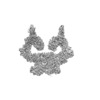







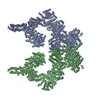
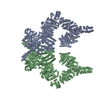

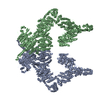

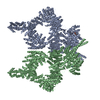



















 X (Sec.)
X (Sec.) Y (Row.)
Y (Row.) Z (Col.)
Z (Col.)





















